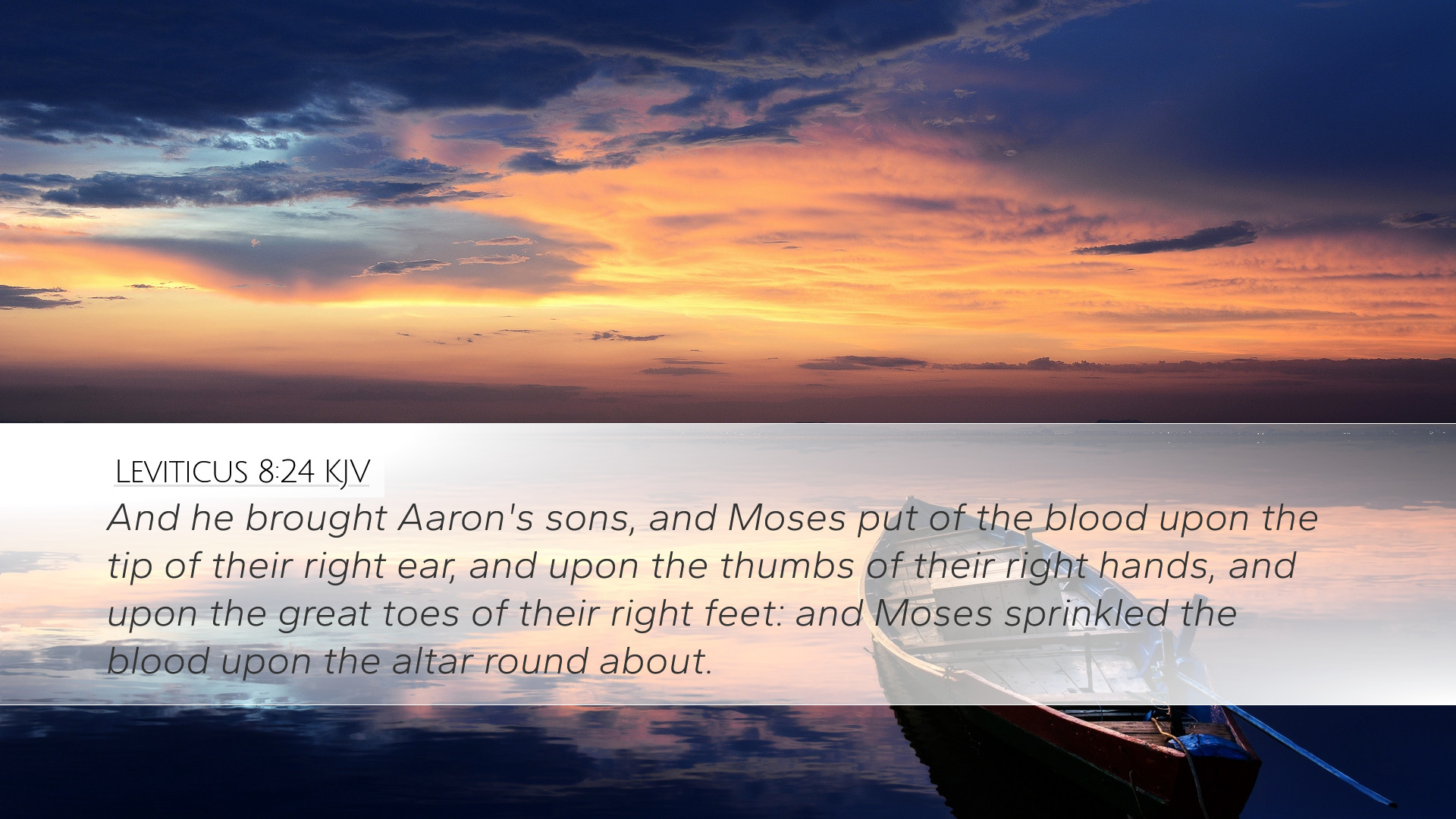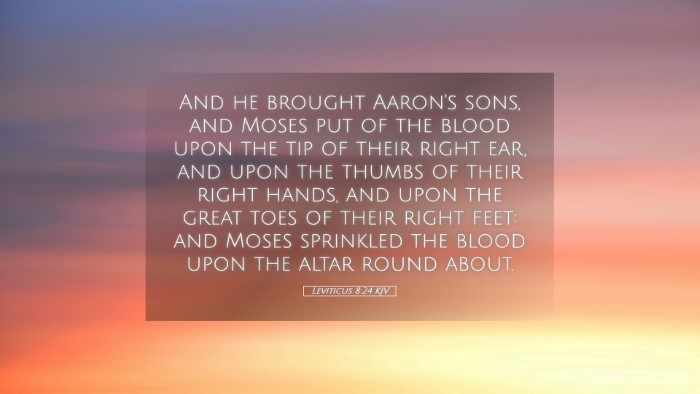Commentary on Leviticus 8:24
Leviticus 8:24 states: "And he brought the bullock for the sin offering: and Aaron and his sons laid their hands upon the head of the bullock for the sin offering." This verse is critical in understanding the sacrificial system in Israel's worship and the ordination of the priesthood. The act mentioned is profound, symbolizing the transfer of sin and guilt.
Overview of the Context
The chapter begins with God's instructions to Moses regarding the consecration of Aaron and his sons as priests. This consecration underscores the importance of priesthood in the covenant community, establishing their role in mediating between God and the people. The actions taken in the ordination ceremony are laden with spiritual significance, particularly the laying on of hands, which indicates identification with the sacrifice.
Insights from Matthew Henry
Matthew Henry emphasizes the ceremonial and symbolic aspects of the sin offering. He notes that laying hands upon the bullock represents the idea of transferring guilt from the people to the innocent victim, a foreshadowing of Christ's ultimate sacrifice. Henry elaborates on the necessity of this atonement ritual, highlighting the depravity of humanity and the need for divine forgiveness.
- Symbolism of the Sin Offering: Henry affirms that the sin offering was a manifestation of the seriousness of sin. It illustrates how sin disturbs the relationship between God and man, necessitating an act of reconciliation.
- The Role of Priests: He points out the unique role of the priests, Aaron and his sons, in facilitating this atoning process, reinforcing the sanctity and responsibility of their office.
Insights from Albert Barnes
Albert Barnes provides a detailed analysis of the ritual components and their theological implications. His commentary elaborates on the significance of laying hands on the animal:
- Transfer of Sin: Barnes asserts that this act symbolizes the transfer of sin and the identification of the sinner with the offering. This ritual embodies the essence of substitutionary atonement.
- Divine Command: He also notes that these practices were divinely instituted, emphasizing the need for obedience among the Israelites to observe these commands as part of their covenant relationship with God.
Insights from Adam Clarke
Adam Clarke contextualizes the text within the broader narrative of the Torah and reflects on its implications for believers today:
- Covenantal Significance: Clarke views this act as integral to establishing a formal covenant between God and His people, where the priest serves as an intermediary.
- Spiritual Applications: He suggests that modern believers can draw parallels between the Old Testament sacrificial system and the New Testament understanding of Christ as the Lamb of God, who takes away the sin of the world.
Theological Implications
The laying on of hands as depicted in Leviticus 8:24 carries profound theological implications that echo throughout redemptive history. It reflects themes of substitution, representation, and the need for a mediator:
- Substitutionary Atonement: This verse serves as a precursor to the New Testament fulfillment in Christ's sacrifice. Just as the animal bore the sin of the people, Christ bore our sins on the cross.
- The Necessity of Mediation: The priesthood is fundamentally about mediation. Aaron and his sons act as intermediaries who bridge the gap between a holy God and sinful humanity.
Practical Applications for Ministry
For pastors and theologians, Leviticus 8:24 invites reflection on the nature of sin, atonement, and the role of the church’s leaders:
- Understanding Sin: A deeper understanding of sin's gravity is essential for effective preaching and counseling.
- Emphasizing Christ's Atonement: The act of laying on hands serves as a reminder to point congregations to Christ as the ultimate sacrifice, emphasizing His role as our great High Priest.
- Leader's Responsibility: This verse also highlights the weight of responsibility that falls upon church leaders as they guide their congregations in faith, ensuring they uphold the sacredness of their calling.
Conclusion
Leviticus 8:24 encapsulates the essence of the sacrificial system established in the Old Testament, pointing forward to the ultimate sacrifice of Jesus Christ and emphasizing the important role of priests in mediating between God and humanity. The insights from historical commentaries provide a layered understanding of this text, revealing its richness and relevance for believers today.


